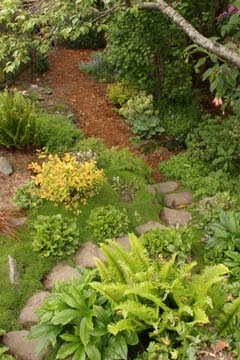|
The garden on Huntoon Streetby AMY STEWART THIS IS THE SECOND YEAR I'VE
MADE AN ADVANCE VISIT to one of the gardens on the Humboldt Botanical
Gardens Foundation's garden tour, and I am amazed at how calm
the gardeners seem to be. I'd be a wreck if I knew that complete
strangers were going to pay money to see my garden in just four
short weeks, but Kathleen Becker and Linda Byrd were cool and
collected, and so was their garden. Becker and Byrd bought their house on Huntoon Street in Eureka in 1995 and they've spent the last eight years converting the damp, sloping lot into a graceful and serene shade garden. To see it now, you'd never guess that they've spent their time jackhammering out walkways, whacking down ivy, and hauling out the garbage -- bottles, cans, wood ashes, even old shoes -- that was once piled there. Invasive ivy and trash heaps were not the only legacies left by the previous owners. The redwood trees, which have probably shaded the yard since the house was built, had been topped at some point, giving them an ungainly appearance. "We've had some branches removed to stabilize the trees," Byrd said, "but if you want an example of why you shouldn't top trees, come see our garden." The redwoods are recovering and they form a canopy over the garden that keeps the sun out and the cool dampness in. "We got a real education about shade gardening," Becker said, explaining that neither of them had much interest in shade gardens before they bought the house. "We lost a lot of plants at first." A sunny alleyway alongside the house became the repository for plants that couldn't cut it in the cool, damp shade, and as they found plants that worked, they set to work propagating them. [Photo ©Hopkins Fine Portraiture] Helleborus, angelica, tree ferns, and, of course, rhododendrons all thrive under the trees. Striking combinations of colored foliage -- bronze and chartreuse, for instance -- make even the shadiest parts of the garden seem bright. In the alley and in the front garden, sun-loving plants like salvia, roses and butterfly bush attract hummingbirds and bees. "I hope we'll encourage more people to plant in their alleys," Byrd said. "We've had people tell us that they walk down this alley on purpose now just to see what's blooming." One of the most surprising features of the garden is a creek that feeds into a drainage pipe. "We noticed that it was just always wet in this low spot in the garden," Becker explained. "So we started digging, and we found water -- a natural spring that was probably once a creek running through the property. We call it our bog garden. Actually, it's more of a swamp, but you don't want to invite people over to see your swamp. Bog sounds better." I asked them if they'd made any radical changes to the garden in anticipation of the tour. "Not really," Byrd said. "We just pushed up a few projects, like the deck at the top of the garden, that we might not have done for a few more years." Becker and Byrd built most of the structures in the garden themselves, including the deck and an ingenious fountain made from two old satellite dishes. I wasn't surprised to learn that they'd used only organic methods from the start. In such a naturalistic setting, chemical fertilizers or pesticides just wouldn't seem right. They've brought in truckloads of compost and shredded bark to build up the soil and used organic pest control products like horticultural oil to combat pests. Their hard work has paid off: The garden has become a refuge for birds and amphibians. "There were very few birds back here when we moved in," Byrd said. "But now we see goldfinches, pine siskins and even hawks. And we do whatever we can to encourage the salamanders." The return of wildlife to the garden more than justifies the use of organic methods. If they had used conventional methods they might not have such an abundance of creatures. "What a price you pay if you don't garden organically," Becker said. HBGF chooses a wide variety of gardens for the tour each year; this one is a great example of a wild, untamed garden on an otherwise ordinary street in Eureka. Be sure to stop by next weekend. The Humboldt Botanical Gardens Foundation's 12th Annual Garden Tour and Tea will be held on Sunday, June 22, from 10 a.m. to 5 p.m. Eleven gardens in Eureka, Arcata, Blue Lake, Bayside and McKinleyville will be open for visitors. The Humboldt State University greenhouse is included on the tour this year, and tea and lemonade will be served at a couple of locations. Proceeds from the tour help support the construction of a botanical garden on a 44.5-acre site adjacent to the College of the Redwoods. Groundbreaking is scheduled for this summer, and the garden is expected to be open to the public in 2004 or 2005. Tickets are $15 for HBGF members and $20 for non-members, and can be purchased at nurseries, garden shops, or from HBGF directly. Call 442-5139 to order or for more information.
garden-related announcements and news to Amy Stewart. IN THE NEWS | COVER STORY | GOOD NEWS | CALENDAR © Copyright 2003, North Coast Journal, Inc. |


